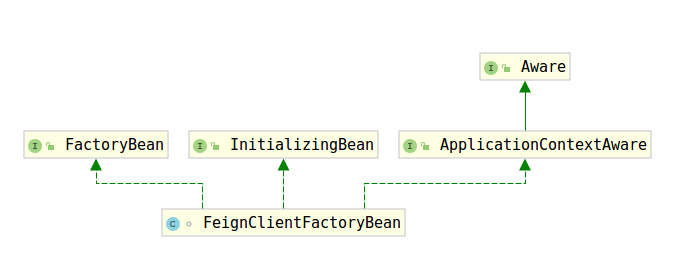您好,登錄后才能下訂單哦!
您好,登錄后才能下訂單哦!
今天就跟大家聊聊有關Feign中FeignClientFactoryBean的作用是什么,可能很多人都不太了解,為了讓大家更加了解,小編給大家總結了以下內容,希望大家根據這篇文章可以有所收獲。

圖1
其屬性如List-1所示,這些屬性的值都是在FeignClientsRegistrar中設置的。
List-1
class FeignClientFactoryBean
implements FactoryBean<Object>, InitializingBean, ApplicationContextAware {
/***********************************
* WARNING! Nothing in this class should be @Autowired. It causes NPEs because of some
* lifecycle race condition.
***********************************/
private Class<?> type;
private String name;
private String url;
private String contextId;
private String path;
private boolean decode404;
private ApplicationContext applicationContext;
private Class<?> fallback = void.class;
private Class<?> fallbackFactory = void.class;
...由于實現了FactoryBean接口,我們來看最重要的getObject()方法,如List-2,getTarget方法中首先從Spring上下文中獲取FeignContext。FeignContext是在FeignAutoConfiguration中注冊到Spring容器中的,如List-3所示,會將spring容器所有的FeignClientSpecification放入到FeignContext中,FeignClientSpecification在Feign源碼分析之EnableFeignClients中講過,即EnableFeignClients的defaultConfiguration。
List-2
@Override
public Object getObject() throws Exception {
return getTarget();
}
<T> T getTarget() {
FeignContext context = this.applicationContext.getBean(FeignContext.class);
Feign.Builder builder = feign(context);
...List-3
public class FeignAutoConfiguration {
@Autowired(required = false)
private List<FeignClientSpecification> configurations = new ArrayList<>();
@Bean
public HasFeatures feignFeature() {
return HasFeatures.namedFeature("Feign", Feign.class);
}
@Bean
public FeignContext feignContext() {
FeignContext context = new FeignContext();
context.setConfigurations(this.configurations);
return context;
}
...List-2中,得到FeignContext后,調用feign方法,從FeignContext中獲取Encoder、Decoder、Contract,其實內部是從spring容器中獲取的,得到Feign.Builder。
我們可以實現RequestInterceptor接口,之后交給Spring容器,feign會自動加上這個攔截器,這個的實現也在FeignClientFactoryBean中,在configureUsingConfiguration方法中,如下List-4
List-4
Map<String, RequestInterceptor> requestInterceptors = context
.getInstances(this.contextId, RequestInterceptor.class);
if (requestInterceptors != null) {
builder.requestInterceptors(requestInterceptors.values());
}List-4中的context.getInstances()方法內部是如何實現的呢。來看下FeignContext的父類NamedContextFactory,List-5中的setConfigurations方法在List-3中調用,在構造FeignContext的時候調用的。
List-5
public void setConfigurations(List<C> configurations) {
for (C client : configurations) {
this.configurations.put(client.getName(), client);
}
}List-6中
getConext方法獲取ApplicationContext,之后從該ApplicationContext中獲取bean
getConext方法中,如過name對應的ApplicationContext不存在,則調用createContext方法進行創建
AnnotationConfigApplicationContext.register方法把配置類注冊到ApplicationContext中,還設置了AnnotationConfigApplicationContext的parent為當前Spring上下文,這樣當在AnnotationConfigApplicationContext中獲取不到bean時,就會從父ApplicationContext中獲取
List-6
public <T> T getInstance(String name, Class<T> type) {
AnnotationConfigApplicationContext context = getContext(name);
if (BeanFactoryUtils.beanNamesForTypeIncludingAncestors(context,
type).length > 0) {
return context.getBean(type);
}
return null;
}
protected AnnotationConfigApplicationContext getContext(String name) {
if (!this.contexts.containsKey(name)) {
synchronized (this.contexts) {
if (!this.contexts.containsKey(name)) {
this.contexts.put(name, createContext(name));
}
}
}
return this.contexts.get(name);
}
protected AnnotationConfigApplicationContext createContext(String name) {
AnnotationConfigApplicationContext context = new AnnotationConfigApplicationContext();
if (this.configurations.containsKey(name)) {
for (Class<?> configuration : this.configurations.get(name)
.getConfiguration()) {
context.register(configuration);
}
}
for (Map.Entry<String, C> entry : this.configurations.entrySet()) {
if (entry.getKey().startsWith("default.")) {
for (Class<?> configuration : entry.getValue().getConfiguration()) {
context.register(configuration);
}
}
}
context.register(PropertyPlaceholderAutoConfiguration.class,
this.defaultConfigType);
context.getEnvironment().getPropertySources().addFirst(new MapPropertySource(
this.propertySourceName,
Collections.<String, Object>singletonMap(this.propertyName, name)));
if (this.parent != null) {
// Uses Environment from parent as well as beans
context.setParent(this.parent);
// jdk11 issue
// https://github.com/spring-cloud/spring-cloud-netflix/issues/3101
context.setClassLoader(this.parent.getClassLoader());
}
context.setDisplayName(generateDisplayName(name));
context.refresh();
return context;
}看完上述內容,你們對Feign中FeignClientFactoryBean的作用是什么有進一步的了解嗎?如果還想了解更多知識或者相關內容,請關注億速云行業資訊頻道,感謝大家的支持。
免責聲明:本站發布的內容(圖片、視頻和文字)以原創、轉載和分享為主,文章觀點不代表本網站立場,如果涉及侵權請聯系站長郵箱:is@yisu.com進行舉報,并提供相關證據,一經查實,將立刻刪除涉嫌侵權內容。